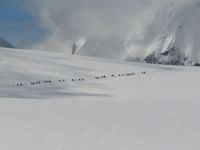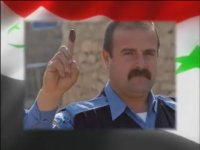Agam's Gecko


Friday, October 06, 2006
TIBETAN REFUGEES SHOT BY CHINESE TROOPS - AT LEAST ONE DEAD
**updated**
 |
| A Tibetan caravan crosses Nangpa Pass, Tibet, near the Nepal border / ICT photo |
| A |
t least one Tibetan Buddhist nun has been killed by Chinese troops in Tibet, and others in her group of more than 70 refugees, on an escape trek to Nepal, were also shot and some possibly killed. The incident on September 30 was witnessed by many foreign mountaineers at Mount Cho Oyu base camp, who reported seeing the Chinese soldiers (or "People's Armed Police") kneel, take aim, and open fire on the refugee group, which included children. Forty-three Tibetans made it safely to Nepalese territory, leaving more than 30 whose fate is not known. Associated Press in India reports at least two deaths and more wounded.
Nangpa La, where the incident occurred, may be seen on this Google Map, with Kathmandu indicated for reference. They would be moving southward across that rugged, frozen terrain at over 18,000 foot altitude. Mount Everest and Mount Cho Oyu are at the centre of this view, with the pass on the western side of them. Zoom in and take a closer look, and contemplate what Tibetans will risk for freedom. There is a section of the lower part of the pass which Google Maps has in higher resolution.
This report via International Campaign for Tibet:
A Tibetan nun in her mid twenties was shot dead by Chinese border patrols and at least one other Tibetan may have been killed while on their way into exile in Nepal on the Nangpa pass five days ago, according to eyewitness reports. Tibetans traveling with the nun were unable to bring her body, with evident wounds from several rounds of bullets, with them because they feared arrest before entering Nepalese territory. There are reports that up to seven more Tibetans may have been killed after the group was fired upon by Chinese armed personnel, but these could not be confirmed. The incident took place on the glaciated Nangpa Pass at 18,753 ft, just a few kilometres west of Mount Cho Oyu, and was witnessed by a number of international mountaineers at advance base camp, who saw Chinese military personnel kneel down, take aim and open fire on the Tibetans, some of whom were children as young as ten.Contact the foreign affairs authority of your country, ask your MP or representative to do the same, and demand a loud and public condemnation of China's actions. Executing people seeking for freedom, throwing them in prisons if they're caught alive, China's atrocious behaviour has got to stop -- it's been going on with little heed from the world for far too long. About 56 years too long.
One of the climbers summiting Cho Oyu, which is approximately 20 km west of Mount Everest at the border between Tibet and Nepal, said in an email communication by satellite that the shooting happened in the early morning of September 30: "I saw a line of Tibetans heading towards the start of the [Nangpa] pass - a common sight. Then, without warning, shots rang out. Over, and over and over. Then the line of people started to run uphill. Watching the line snake off through the snow, as the shots rang out, we saw two shapes fall. The binoculars confirmed it: two people were down, and they weren't getting up."
A second climber, a British mountain guide, told ICT that other climbers had witnessed one of the Tibetans getting up after they had fallen, indicating that one of the two might have survived, although it is not known if the person died later from their injuries. Mountaineers contacted by ICT did not wish to be named until they had left Chinese territory, and the full circumstances of what led up to the incident are not known.
Forty-three Tibetans from a group of more than 70 escaping from Tibet were apparently able to escape from the gun-fire and safely reach Nepalese territory, where they are now en route to the Tibetan Refugees Reception Center in Kathmandu. Most of the group, including children as young as ten as well as Tibetans in their twenties and thirties, are apparently from Kham in eastern Tibet. According to local sources, the Tibetans feared that there might be more than one fatality. The whereabouts of the more than 30 remaining Tibetans from the group is not known. A local Tibetan source said that these Tibetans might have been apprehended by Chinese security forces because Chinese military vehicles, including ambulances, had been seen at a motorable road close to the incident area on the same day. Another local Tibetan source said that members of the group had been forced to abandon the bullet-ridden body of the nun on the pass, because they feared that carrying it out of Tibet might lead to their arrest.
The British mountain guide, who was summiting Cho Oyu at the time, told ICT: "There could have been as many as 60 climbers at Advance Base Camp who witnessed the incident. They could see Chinese soldiers quite close to Advance Base Camp kneeling, taking aim and shooting, again and again, at the group, who were completely defenceless. We didn't know what the targets were but the climbers could see they were human beings. A couple of hours later, a caravan of yaks came along the pass from Nepal and there was no shooting. Clearly distinctions were made between intended targets. This was a deeply shocking incident for all of us."
Read more...
Nepal must not escape scrutiny either. The Nepali authorities have a terrible record of submission to Chinese influence, and have repeatedly engaged in the illegal refoulement of legitimate refugees into the waiting hands of the Chinese authority in Tibet, where they face imprisonment, featuring real torture (not belly slaps and Manilow music, I mean actual torture). Most Tibetan refugees only seek to transit Nepal on their way to freedom in India, but Nepal has hindered humanitarian assistance for them with the closure of the Dalai Lama's representative office and the Tibetan Refugee Welfare Office in Kathmandu (at China's urging, of course). Other agencies have provided some help through a refugee center, in spite of obstruction by the Nepali government. For more background on the challenges faced by Tibetan refugees today, see the International Campaign for Tibet's 2005 report, Dangerous Crossing.
China expects to get a big face in two years time, with the Beijing Olympic Games. In their periodic talks with delegates from the Tibetan Government in Exile, the Chinese have met a sincere willingness to solve the issue with compromise, and have responded with intransigence and continuing slander against the Dalai Lama. They intend to leave an impression of incremental progress to keep the pressure off until after their big world event, after which the world will have no more leverage and they can simply await the Dalai Lama's death. Problem solved, or so they appear to think.
No reasonable person could have countenanced the holding of Olympic Games in the old East Germany during the 1970's or 80's, when that communist regime was shooting people trying to escape to freedom. It would have been unthinkable, right? The world's democracies must come together on that same principle now, and affirm to China that serious progress needs to be made toward a mutually agreeable solution on the Tibet issue, now. They need to be told that continued stalling tactics will be met with an Olympic boycott.
Tibetans have a right to their own country, which had existed separate from the Chinese empire for hundreds of years, and as affirmed in a formal declaration of Tibetan statehood in 1911. Yet even today, the TGIE is not asking for independence, but rather a negotiated special autonomy within the "People's" Republic. The Dalai Lama doesn't want to rule in any way, only to return home to his people. He, and his exiled countrymen and women have been building a democratic system of governance outside their homeland for 40 years. They are willing to settle for much less than is their right, and hope only to have a very old promise honoured. The Tibetans were assured of genuine autonomy and self government by the Chinese communists in the middle of the last century. The next two years may be the last chance to get that promise kept.
UPDATE: A mountaineering team from the Philippines were among those who witnessed the killings. The climbing team's doctor, Dr. Ted Esguerra spoke to the Philippine Daily Inquirer on the day of the shooting, as reported on TibetanAvenue Blog. Dr. Esguerra said he saw "at least three people -- two women and a man -- shot dead on the Nangpa La pass," adding that "as many as seven people might have been killed."
A few more climbers' accounts on the Mount Everest Net website, here and here.
Labels: Tibet











 Our way of saying "thanks" in the Thai way. Here a nak muay Thai (kickboxer) offers respect and thanks for his teacher (wai khru) before a match. This is our local variation on the ubiquitous "hat tip" used in general blog culture.
Our way of saying "thanks" in the Thai way. Here a nak muay Thai (kickboxer) offers respect and thanks for his teacher (wai khru) before a match. This is our local variation on the ubiquitous "hat tip" used in general blog culture.




